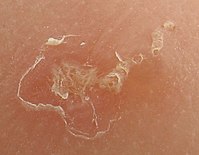
Photo from wikipedia
We read with great interest the recent paper by Torre-Castro and colleagues on three cases of nonneural granular cell tumors (NNGCT) immunoreactive with cyclin D1. We would like to contribute… Click to show full abstract
We read with great interest the recent paper by Torre-Castro and colleagues on three cases of nonneural granular cell tumors (NNGCT) immunoreactive with cyclin D1. We would like to contribute by adding a further case and comparing it with a typical epithelioid histiocytoma. Briefly, a 55-year-old woman presented with a slowly enlarging, asymptomatic, whitish nodule in the first interdigital space of the right foot. A punch biopsy was performed with a clinical suspicion of a cyst. On histopathology, a solid proliferation of epithelioid cells with abundant, eosinophilic, granular cytoplasm was present in the dermis (Figure 1A). The nuclei were small and centrally located; no mitotic figures were present (Figure 1B). Immunohistochemical stainings showed equivocal immunoreactivity for histiocytic markers, namely, CD68 was positive while CD1a and BRAF were negative. In addition, the lesion was strongly immunoreactive for ALK (Figure 1C) and cyclin D1 (Figure 1D), while it was negative for S100 (Figure 1E), MART1 and pankeratin. It has been hypothesized that NNGCT are granular cell dermal root sheath fibromas, being related to the hair follicle, or they are
Journal Title: Journal of Cutaneous Pathology
Year Published: 2021
Link to full text (if available)
Share on Social Media: Sign Up to like & get
recommendations!